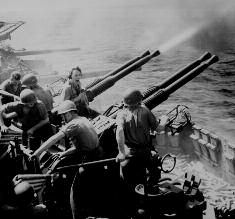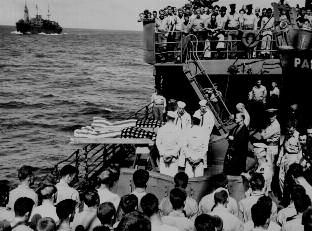Stories of Faith and Courage From World War II (51 page)
Read Stories of Faith and Courage From World War II Online
Authors: Larkin Spivey
Tags: #Religion, #Biblical Biography, #General, #Spiritual & Religion

It isn’t too often I have to write a letter like this one. This is a pre-invasion letter. We go into Guam tomorrow. I am not so much afraid now, but tomorrow morning, no doubt, I will be plenty scared…
If the worst should happen to me, know that it is God’s will, and I gave my life for the Church and the God who rules it. I took the vow at ordination to obey. My work here is obedience at its best.
Yes, no doubt, I will be doubly scared on this major operation. Christ was scared when He was going to His death, for He cried out “Father, if it be possible, let this chalice pass from me.” He did it for me, I must do it for Him. I’d go in if it were even to save one soul.
All the good I am going to do in there makes me courageous for “Courage is fear that has said its prayers.” And there is no greater prayer than squaring souls away for God.
384
I have never seen a better definition of courage. By taking our fears to God in prayer, we are able to face any challenge in his strength. Courage is knowing we have access to this strength and that it will sustain us, no matter what threatens our physical or spiritual safety.
His divine power has given us everything we need for life and godliness through our knowledge of him who called us by his own glory and goodness.
—2 Peter 1:3
When the Roll Is Called
Jake DeShazer was laid to rest in March 2008. The World War II Doolittle Raider and Christian evangelist received full military honors. Hundreds of people honored the man who had suffered three years as a prisoner of war in Japan and then returned after the war to start twenty-three churches and bring many thousands of Japanese citizens to Jesus Christ. One of his children said, “He wouldn’t want this service to be about his accomplishments. He’d want Jesus to get all of the credit.”
385
During the funeral there was a rifle salute, and a lone bugler blew taps. A B-1 bomber flew over from the modern equivalent of Jake’s old squadron, the 34
th
. The casket flag was folded and presented to his wife. The sergeant in charge of the honor guard said, “Jake’s a hero. This is why we do military honors, to honor people like Jake. He’s history.”
386
The service itself was simple. The pastor said a few words and prayed. Then everyone sang a hymn that was Jake’s favorite, and one dear to the heart of many airmen, “When the Roll Is Called Up Yonder”:
When the trumpet of the Lord shall sound, and time shall be no more,
And the morning breaks, eternal, bright and fair;
When the saved of earth shall gather over on the other shore,
And the roll is called up yonder, I’ll be there.
On that bright and cloudless morning when the dead in Christ shall rise,
And the glory of His resurrection share;
When His chosen ones shall gather to their home beyond the skies,
And the roll is called up yonder, I’ll be there.
Let us labor for the Master from the dawn till setting sun,
Let us talk of all His wondrous love and care;
Then when all of life is over, and our work on earth is done,
And the roll is called up yonder, I’ll be there.
387
And I saw the dead, great and small, standing before the throne, and books were opened. Another book was opened, which is the book of life.
—Revelation 20:12
Mascot
The USS
Samuel B. Roberts
was ready for combat. Newly constructed, outfitted, and manned by an eager crew, she was ready to leave Norfolk for the Pacific theater. She needed just one more crew member. After an evening ashore involving more than a small amount of drinking, several enlisted men smuggled a little black dog back aboard. It wasn’t long before Capt. Bob Copeland found out about this unauthorized stowaway on his ship.
As the sailors waited nervously to find out what was going to happen, Copeland called for the ship’s doctor and chief yeoman. He informed them that they had a new crew member that needed a complete physical exam and official service record. After these formalities, the little mutt was named “Sammy,” adopted as the ship’s mascot, and given the rank of seaman 2
nd
class. He quickly became a valuable part of the ship’s company. Someone made him a little kapok life vest. An article appeared in the ship’s newsletter that Sammy had a girlfriend in Tokyo and had selected the
Roberts
as the fastest way to cross the Pacific.
For a young man of thirty-three years, Bob Copeland was a uniquely mature and talented leader. He never hesitated to exert his authority as captain of his ship, but he did so in a way that gained the respect of the men. He frequently stopped to talk with them and to ask about their families and girlfriends. Gestures of this kind, including the adoption of Sammy as mascot, showed his human side to the crew. This human touch also introduced a few warm feelings into an otherwise cold sea-going life. Bob Copeland knew the importance of his mission. He also knew that he would not be able to accomplish that mission without an effective, close-knit team. By his actions, he demonstrated a great Christian truth, that bonds of affection between men are even more powerful than the bonds of authority.
388
For the law was given through Moses; grace and truth came through Jesus Christ.
—John 1:17
Overwhelming Odds
“A large Japanese fleet has been contacted. They are fifteen miles away and headed in our direction. They are believed to have four battleships, eight cruisers, and a number of destroyers. This will be a fight against overwhelming odds from which survival cannot be expected. We will do what damage we can.”
389
Bob Copeland, captain of the destroyer escort USS
Samuel B. Roberts
, spoke these words to his crew and turned his little ship to face a menacing enemy fleet. The
Roberts
was part of a destroyer screen protecting six escort aircraft carriers off the coast of Leyte in October 1944. The Japanese fleet had come undetected through the San Bernardino Strait the night before and now announced its presence with salvos of 3,200-pound projectiles fired from its18-inch guns.
Outmatched in size, firepower, and speed, the
Roberts
and three other destroyers nearest the enemy fleet launched a desperate attack. They laid a smokescreen to give some cover to the carriers and opened up with their 5-inch guns, which could do little more than annoy the massive Japanese warships. Their only effective weapons were torpedoes, which had to be fired at close range. The
Roberts
steamed ahead through a mounting hail of naval gunfire to within four thousand yards of the enemy battle line to launch her torpedoes and score a hit on an enemy cruiser. The little warship in return suffered devastating and fatal damage from multiple shell strikes. Within a few hours the
Roberts
went down stern first with the loss of ninety crewmen.
Two other destroyers were lost that morning in one of the most gallant actions in U.S. naval history. By sheer determination the sailors of this tiny force slowed and disorganized the Japanese advance, buying time for air attacks to turn the tide of the battle. Admiral Nimitz stated: “The history of the United States Navy records no more glorious two hours of resolution, sacrifice, and success.”
390
This would be the last surface engagement of the war and one of the finest hours of the U.S. Navy.
Saul replied, “You are not able to go out against this Philistine and fight him; you are only a boy, and he has been a fighting man from his youth.”
—1 Samuel 17:33

40mm guns in action against attacking aircraft. (National Archives)

Burial at sea for sailors killed in action. (National Archives)
Powder in the Scuttle
The destroyer USS
Heermann
churned ahead at maximum speed toward the Japanese cruiser formation. Incoming shells spouted huge geysers in a rainbow of colors all around the little ship. Red, yellow, and green dye marked the rounds from different enemy guns.
The
Heermann
was trying desperately to screen the wounded and badly listing escort carrier,
Gambier Bay
, by laying smoke and disrupting the enemy advance. She had only her 5inch guns to bear on the larger Japanese ships closing in. The
Heermann
’s five mounts kept up a steady cadence as each gun crew worked feverishly through the loading cycle over and over again. Fifty-four-pound projectiles came up the shell hoists to be fused and hand-loaded into the breeches. Twenty-eight-pound powder bags were pushed up through scuttles for loading behind the projectiles. The smell of cordite and human sweat became overpowering, especially for the men below decks in the confined spaces of the handling rooms. One sailor described the experience:
Round after round I take from Sacco, placing it in the scuttle. As the previous round is removed, I push up a new one and secure it in its seat. Forty, fifty rounds, then the violent action of the ship, a brief pause. Just enough time to bring up more shells from the lower handling room. Many times more, rapid fire, no time for thought. Keep a powder charge in the scuttle. No talk, only Sacco’s orders to keep the lower hoist moving. The human machine works flawlessly. We still know nothing of the happenings around us. No feelings, no interruptions, just keep a powder in the scuttle.
391
As happens so often in combat, we see men working together to do a job with no idea of the bigger picture around them. They had to get their part done while having faith that others would do theirs and that the overall battle would be fought wisely. This remains a powerful metaphor for our lives in Christ. We try to use our gifts conscientiously in his service while resting in the confidence that he is in control of the outcome.
But those who hope in the L
ORD
will renew their strength. They will soar on wings like eagles; they will run and not grow weary, they will walk and not be faint.
—Isaiah 40:31
Reaching Back
The modern guided missile frigate USS
Samuel B. Roberts
was commissioned in 1986, a direct descendant of the World War II ship of the same name lost at Leyte Gulf. In memory of his ship’s ancestor, the captain, Cdr. Paul X. Rinn, had a bronze plaque made with an image of the first
Roberts
and a roster of her crew engraved on it. The plaque was prominently displayed on the quarterdeck of the ship and was a key point in the indoctrination of each new crew member.
In 1988 the new
Roberts
struck a mine while escorting Kuwaiti oil tankers in the Persian Gulf. With a fractured keel and twenty-five-foot hole in the hull she was taking on massive amounts of seawater and in imminent danger of sinking. Captain Rinn thought, “I’m not sure we can save this ship, but we’ve got to try…”
392
Working feverishly through a long night he and a determined crew saved the ship. During the night the bronze plaque on the quarterdeck took on a new significance.
